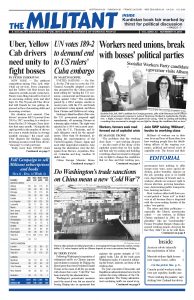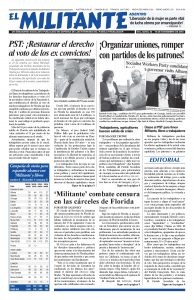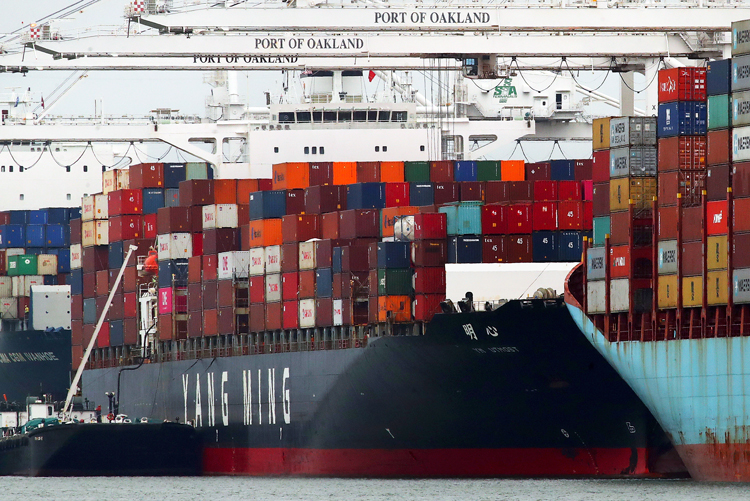Following Washington’s imposition of widespread tariffs on Chinese imports and retaliatory measures by Beijing, the liberal press that views President Donald Trump as the cause of all ills are awash with claims that a new “Cold War” has been started by his administration.
Washington’s protectionist measures aren’t the onset of war, but are aimed at forcing Beijing into an agreement that registers the greater strength of U.S. capital today. Like all the trade pacts Washington seeks, it’s aimed at advancing the bosses’ interests, not those of the working class.
For years successive Democratic and Republican administrations have tried to contain the rising influence of the Chinese capitalists. The Trump administration’s escalating tariffs are aimed at upping this pressure, not replicating last century’s clashes between Washington and Moscow.
When the U.S. rulers emerged as top dog out of the second imperialist world war, they viewed Asia as their biggest prize. They looked forward to sending troops into China to help ally Chiang Kai-shek defeat Mao Zedong and open the country to Washington’s pillage.
But U.S. workers in uniform refused to go, holding rallies of tens of thousands in the Philippines and elsewhere demanding to be brought home. The mass peasant army led by Mao took power and, when Washington threatened war in Korea, overturned capitalist property relations. The U.S. rulers were fought to a standstill in Korea and then defeated outright by the workers and peasants in Vietnam.
After the fall of the Stalinist Mao regime, Chinese Communist Party leaders increasingly turned to capitalist market production. Capitalist bosses drove a massive growth of industry and trade — and of the working class — over the last three decades.
Washington remains the dominant power in the Pacific, but that dominance is being challenged.
U.S. rulers seek better deal
In today’s clashes between Washington and Beijing over which power will be better placed to appropriate the wealth created by workers and farmers, Washington still has a significant advantage — the massive size of the U.S. economy, the dollar’s role as world currency and overwhelming superiority of its military might.
The capitalist economy in China began slowing down prior to the impact of the 10 percent tariffs Trump levied on $250 billion worth of Chinese-made goods sold in the U.S. But the impact of the tariffs has accelerated the slowdown. Factory orders across China fell to their lowest level in two years in October. Chinese capitalists sell far more in the much bigger U.S. market than U.S. capitalists sell in China and will feel the impact of the tariffs Washington imposes much more sharply than their U.S. counterparts will feel Beijing’s retaliatory steps.
National Economic Council Director Lawrence Kudlow reiterated Washington’s demands Nov. 2, saying Beijing has to offer U.S. capitalists more access to markets in China, reduce government subsidies to Chinese companies and stop what he says are its efforts to force U.S. investors in China to hand over technology.
The U.S. government claims its tariffs advance “American interests,” when in reality they advance the class interests of those who exploit working people at home and abroad. The Socialist Workers Party is “unconditionally opposed to the rulers of the United States imposing protectionist barriers of any kind under any pretext on imported goods,” explained Jack Barnes, the party’s national secretary, in the article “Our Politics Start with the World” in New International no. 13.
Following a conversation with Chinese President Xi Jinping Nov. 2, Trump claimed Beijing wants to make a deal with Washington “very badly.” They plan to talk at the upcoming Group of 20 summit in Argentina.
Alongside protectionist measures against the Chinese capitalists, Washington is pouring more money into its military machine while it presses allies in the Philippines, Japan and Australia to step up countering Beijing’s moves to establish itself as a naval power.
The Japanese government agreed Oct. 30 to construct a new military base for U.S. forces on the island of Okinawa, despite the longstanding vocal opposition of working people there.
The Chinese rulers claim almost all of the South China Sea as their property and have constructed a series of artificial islands on reefs there, replete with military bases.
The U.S. rulers maintain a naval force worldwide that dwarfs its rivals. They deploy 20 aircraft carriers, while Beijing currently has a single Soviet-era aircraft carrier. Alongside this Washington maintains bases across the Pacific, including 50,000 troops in Japan, 28,500 in South Korea and 5,000 in Guam.
Rising competition among rival capitalist rulers is built into the system. Equally inevitable is the fact that capitalist bosses in the U.S. and China will confront growing working-class skirmishes at home, as workers seek to build unions, engage in social and political struggles and take steps toward building their own parties to fight for political power.


